Where do multicopters fly? Technology roadmap
No one will argue that multikopter is not only a hobby for modellers. In addition to entertainment, they can find many useful applications in various fields. But in general, they are able to perform only two main functions:
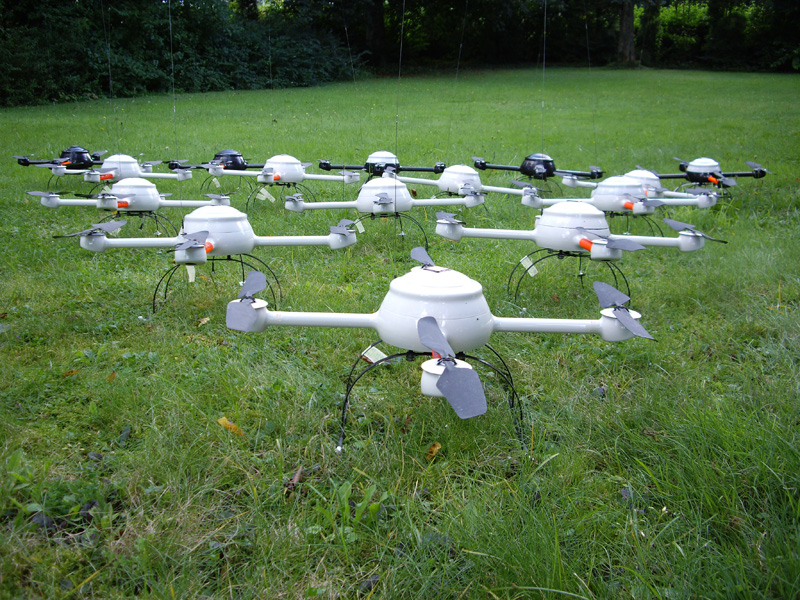
When networking or swarming multicopter, these functions can be performed very efficiently.
For example, coordinated efforts will allow the transportation of cargo that cannot be lifted by a single device. Or another example, a distributed swarm can simultaneously collect information and transmit it on the principle of peer-2-peer networks.
I wonder what awaits them in the future. I will try to answer this question using data for unmanned aerial vehicles.
Here are two reports showing the perspectives of unmanned aerial vehicles (UAVs) and unmanned aerial systems (BPLS):
For reference: BPLS = UAV + ground control station
')
According to these reports, besides military and scientific, the following areas of commercial and civilian use are promising:
The first 2 areas cover about 90% of all known FPL markets in the United States. The total expected economic effect for the USA in 2015 will amount to $ 2,276 million and more than 23 thousand new jobs.
The graphs below show the numbers until 2025.
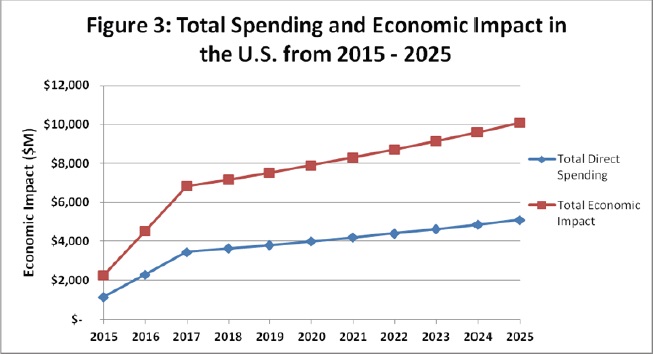
Total costs and economic effect
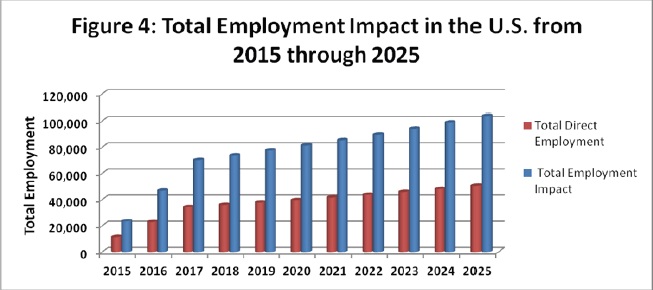
Job growth
It is very important to achieve such growth in resolving issues of state regulation and insurance when using airspace and ensuring flight safety.
But besides government regulation and insurance, a number of technologies will be required. What technologies are needed?
The Department of Defense and the United States Federal Aviation Administration refer to the following research areas:
Anyone can try their hand at developing these technologies.
Here are examples of the results.
I was also interested in the topic of increasing the range and duration of flight for multikopter, as one of the highest priority.
I put forward for discussion two decisions on increasing the range and duration of flights of multicopter.
I ask knowledgeable habravchan to participate and give answers to your questions.
Combine multikopter with the wing and get a new kind of VTOL. No aileron and other moving parts (except propellers).
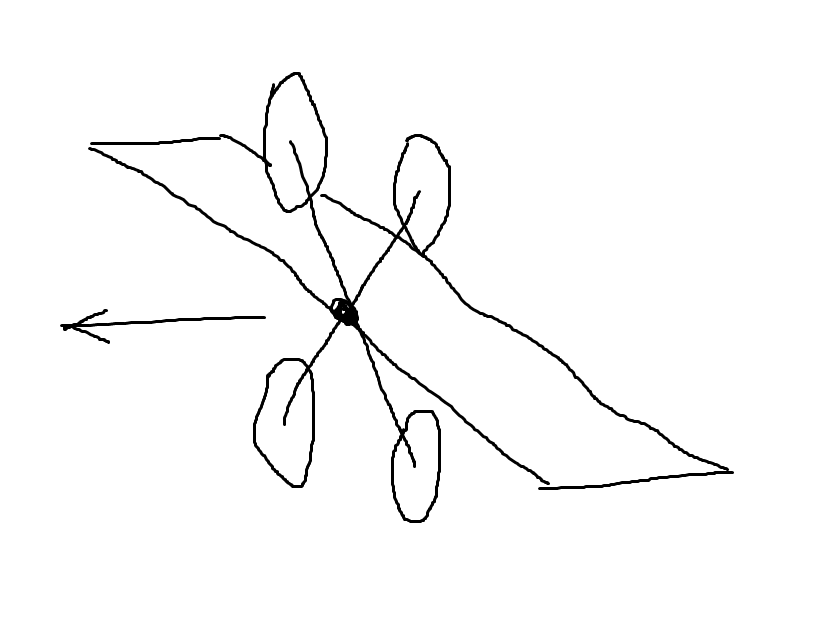
This solution is obvious, but so far I have not been able to find evidence that it was successfully implemented in this form.
Issues for discussion:
Why? What are the disadvantages of this solution?
Here are the most successful examples of similar solutions:
and this windmill
More extensive topic. As they say, is in the air. The meaning of the decision in the organization of a network of filling stations. Ideally - automatic.
Here the situation is better. There are specific designs. Take it and do it.
Here are examples of works on this topic:
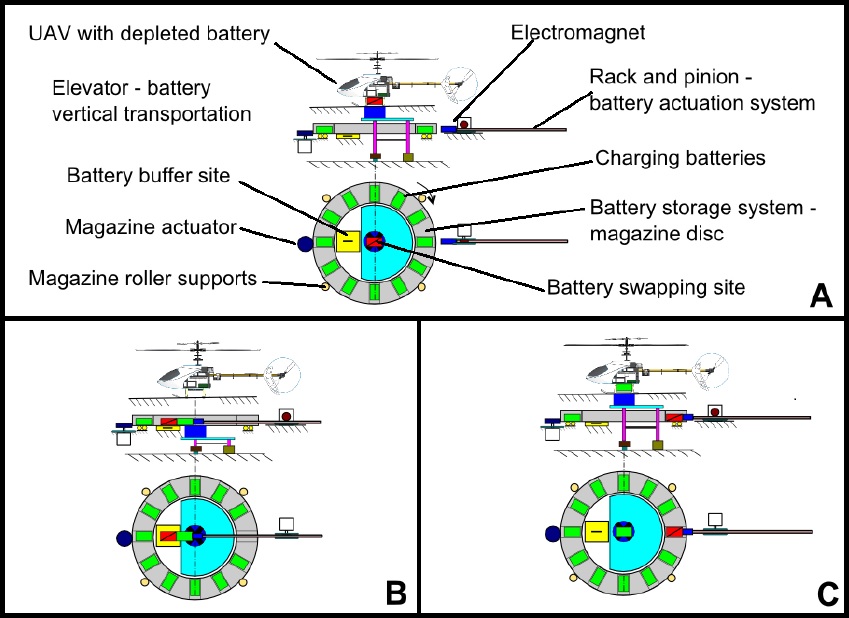

But there is a problem with the organization of a network of such stations with a fairly dense coverage of the territories.
Issues for discussion:
What prevents to organize such a network, for example, in one of the Moscow Region districts by volunteer forces?
What technical problems should be solved?
Has anyone already tried an autonomous nonstop flight to transport something to a friend or neighbor?
What should be the distance, height, trajectory between the nodes of the network in accordance with the technical capabilities and regulations of regulators?
Is automatic landing for recharging or battery replacement implemented?
First you need to understand how far a reliable autonomous flight is possible from all points of view (technical, regulatory, legislative).
Then map the coordinates of the volunteers and understand the coverage areas and distances between them.
If the zones overlap, you can move on. Determine the refueling procedure. Well, and so on.
It is clear that the task is complicated, but it is interesting that such a network should work and start transporting goods.
I invite you to discuss.
As a result of the discussion, I plan to formulate criteria (quantitative and qualitative) for the feasibility of the ideas described. Ideally, I would like to get the TK.
Let's dream and compare this project with ARPANET. And after 30 years, imagine that this network (already the name is MatterNet) enmeshes all the continents, and even across the oceans chains of drifting refueling platforms will be transferred.

There are no borders and customs, mail does not exist. Parcels from ebay and aliexpress from China go on their own on the multicopter.
In the comments to this post there were enough ideas for implementation. As they say things are small.
habrahabr.ru/post/181139
- data collection and transmission
- cargo transportation

When networking or swarming multicopter, these functions can be performed very efficiently.
For example, coordinated efforts will allow the transportation of cargo that cannot be lifted by a single device. Or another example, a distributed swarm can simultaneously collect information and transmit it on the principle of peer-2-peer networks.
I wonder what awaits them in the future. I will try to answer this question using data for unmanned aerial vehicles.
Perspectives drones
Here are two reports showing the perspectives of unmanned aerial vehicles (UAVs) and unmanned aerial systems (BPLS):
- Civil UAV Capability Assessment. Draft version. Nasa December 2004. Despite the fact that the report is dated 2004, it is worth looking at it. Available for download here: www.nasa.gov/centers/dryden/research/civuav/civ_uav_index.html
- The economic impact of unmanned aircraft systems integration in the United States. AUVSI. March 2013. Available for download here: www.auvsi.org/econreport
For reference: BPLS = UAV + ground control station
')
According to these reports, besides military and scientific, the following areas of commercial and civilian use are promising:
- exact agriculture
- public safety
- forest fire fighting
- agriculture monitoring
- emergency management
- inspection of linear infrastructure (power lines, pipelines)
- strengthening law enforcement
- telecommunications
- weather monitoring
- aerial photography and video mapping
- television, cinema (filming reports, movie scenes)
- environmental monitoring
- oil and gas exploration
- freight transportation
The first 2 areas cover about 90% of all known FPL markets in the United States. The total expected economic effect for the USA in 2015 will amount to $ 2,276 million and more than 23 thousand new jobs.
The graphs below show the numbers until 2025.

Total costs and economic effect

Job growth
It is very important to achieve such growth in resolving issues of state regulation and insurance when using airspace and ensuring flight safety.
But besides government regulation and insurance, a number of technologies will be required. What technologies are needed?
The Department of Defense and the United States Federal Aviation Administration refer to the following research areas:
- Interaction and modularity - development of interaction interfaces between modules (sensors, controllers, etc.) to reduce development time
- Communication systems - increased range, capacity and noise immunity
- Cybersecurity — Enhancing the Security of a FPL from Threats to Unauthorized Access and Information Disclosure
- Continuous improvement - improvement of such characteristics as dimensions, weight, power, cooling, reliability, controllability, survivability, etc.
- Autonomy and cognitive behavior - reducing the cost of manual human control
- Armament - purely military use
- Sensor landing - collecting information and performing other tasks on the surface
- Meteorology - collecting information for accurate weather prediction
- High-performance computing - an increase in the number of sensors and the amount of information collected requires an increase in the efficiency of calculations.
- Collision Avoidance - technologies that allow to avoid collisions, both in the air and on the ground
- Remote monitoring and control - change of tasks during the flight, management of UAV groups
- Flight range and duration - understand what I mean
- Flights in the ranks - the exact positioning of the UAV relative to each other in the ranks
- Vertical flights - moving in a vertical direction for high-altitude research
- Docking - on the ground and in the air with cargo, other UAVs, etc.
- Management in case of unforeseen situations - minimization of consequences in case of UAV accidents and in other situations
Anyone can try their hand at developing these technologies.
Here are examples of the results.
I was also interested in the topic of increasing the range and duration of flight for multikopter, as one of the highest priority.
Two solutions to increase the range and duration of the flight
I put forward for discussion two decisions on increasing the range and duration of flights of multicopter.
I ask knowledgeable habravchan to participate and give answers to your questions.
Copter + Wing
Combine multikopter with the wing and get a new kind of VTOL. No aileron and other moving parts (except propellers).

This solution is obvious, but so far I have not been able to find evidence that it was successfully implemented in this form.
Issues for discussion:
Why? What are the disadvantages of this solution?
Here are the most successful examples of similar solutions:
and this windmill
Ground infrastructure
More extensive topic. As they say, is in the air. The meaning of the decision in the organization of a network of filling stations. Ideally - automatic.
Here the situation is better. There are specific designs. Take it and do it.
Here are examples of works on this topic:
- Automatic Battery Replacement System for UAVs: Analysis and Design. Koji AO Suzuki Paulo Kemper F. James R. Morrison. Received: February 15, 2011 / Accepted: April 3, 2011
- UAV Consumable Replenishment: Design Concepts for Automated Service Stations. Paulo Kemper F.1 ∙ Koji AO Suzuki2 ∙ James R. Morrison3 *


But there is a problem with the organization of a network of such stations with a fairly dense coverage of the territories.
Issues for discussion:
What prevents to organize such a network, for example, in one of the Moscow Region districts by volunteer forces?
What technical problems should be solved?
Has anyone already tried an autonomous nonstop flight to transport something to a friend or neighbor?
What should be the distance, height, trajectory between the nodes of the network in accordance with the technical capabilities and regulations of regulators?
Is automatic landing for recharging or battery replacement implemented?
First you need to understand how far a reliable autonomous flight is possible from all points of view (technical, regulatory, legislative).
Then map the coordinates of the volunteers and understand the coverage areas and distances between them.
If the zones overlap, you can move on. Determine the refueling procedure. Well, and so on.
It is clear that the task is complicated, but it is interesting that such a network should work and start transporting goods.
I invite you to discuss.
As a result of the discussion, I plan to formulate criteria (quantitative and qualitative) for the feasibility of the ideas described. Ideally, I would like to get the TK.
Not far away...
Let's dream and compare this project with ARPANET. And after 30 years, imagine that this network (already the name is MatterNet) enmeshes all the continents, and even across the oceans chains of drifting refueling platforms will be transferred.

There are no borders and customs, mail does not exist. Parcels from ebay and aliexpress from China go on their own on the multicopter.
In the comments to this post there were enough ideas for implementation. As they say things are small.
habrahabr.ru/post/181139
Source: https://habr.com/ru/post/209104/
All Articles